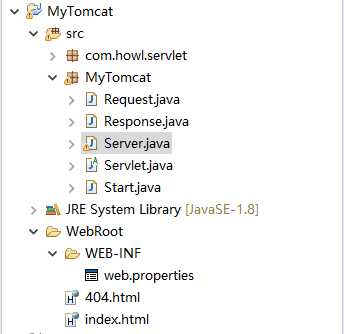标签:注释 超时 name 设计 info 响应头 block ESS 简易
学习JavaWeb之后,只知道如何部署项目到Tomcat中,而并不了解其内部如何运行,底层原理为何,因此写下此篇博客初步探究一下。学习之前需要知识铺垫已列出:Tomcat目录结构、HTTP协议、IO、网络编程(未完善)
笔者称自己手写的Tomcat为盗版,反之则为正版。在手写简易版Tomcat之前,我们来看看如何使用正版的Tomcat
这里以Myeclipse为例

新建MyServlet类继承HttpServlet,重写里面的doPost、doGet方法
public class MyServlet extends HttpServlet {
@Override
public void doGet(HttpServletRequest req, HttpServletResponse resp) throws ServletException, IOException {
resp.getWriter().write("This is serlvet");
}
@Override
public void doPost(HttpServletRequest req, HttpServletResponse resp) throws ServletException, IOException {
}
}写完MyServlet之后要让Tomcat知道他在哪,什么地址映射情况才会启用他
<?xml version="1.0" encoding="UTF-8"?>
<web-app xmlns:xsi="http://www.w3.org/2001/XMLSchema-instance"
xmlns="http://xmlns.jcp.org/xml/ns/javaee"
xsi:schemaLocation="http://xmlns.jcp.org/xml/ns/javaee
http://xmlns.jcp.org/xml/ns/javaee/web-app_3_1.xsd" id="WebApp_ID" version="3.1">
<display-name>tomcat</display-name>
<servlet>
<servlet-name>MyServlet</servlet-name>
<servlet-class>com.howl.MyServlet</servlet-class>
</servlet>
<servlet-mapping>
<servlet-name>MyServlet</servlet-name>
<url-pattern>/howl</url-pattern>
</servlet-mapping>
</web-app>这里放出项目的目录结构

这里使用自带的Tomcat,一键添加部署,再启动(本项目叫tomcat)



至此我们已经能简单地使用正版Tomcat来访问静态资源、Servlet,那么接下来就开始盗版之旅
我们来缕清 浏览器发送请求,然后服务器响应浏览器 到底经历了什么
上面只是简易版的流程,并不完全正确,笔者这里为了方便而简化的流程,具体像Servlet实例化时间,defaultServlet、多层映射这些并未提及
到现在我们可以知道,简易版的Tomcat设计的对象大概有:
给出目录能让人一目了然,并在下面的阅读中有个大概

负责将浏览器的请求信息封装起来,当然这里是简单得不能再简单的封装了,详细内容可看代码里的注释
public class Request {
// 请求地址
private String url;
// 请求方法
private String method;
// 构造函数,参数为后面2.4中Socket建立的IO流
public Request(InputStream in) throws IOException{
// IO读取请求
// 这里踩坑、因为http/1.1是长连接,所以浏览器未超时是不会主动关闭的
// 不能使用循环来读取数据,因为读取不了-1(未主动关闭)
byte[] bytes = new byte[1024];
int length = in.read(bytes);
String str = new String(bytes,0,length);
// 取请求的第一行(具体请求信息请看序文中的HTTP知识铺垫)
String strFirst = str.split("\n")[0];
// 按空格分割
String[] arr = strFirst.split(" ");
// 从第一行中获取方法名和请求地址
method = arr[0];
url = arr[1];
}
public String getUrl() {
return url;
}
public void setUrl(String url) {
this.url = url;
}
public String getMethod() {
return method;
}
public void setMethod(String method) {
this.method = method;
}
}负责封装响应信息,这里注意响应信息有状态码
public class Response {
private OutputStream out;
public Response(OutputStream out) {
super();
this.out = out;
}
// 该方法前面的步骤都是为了写好响应头,最后一句话才是写入响应内容
public void write(String content, int statusCode) throws IOException{
out.write( ("HTTP/1.1 " + statusCode + " OK\n").getBytes() );
out.write("Content-Type:text/html;Charset=utf-8\n".getBytes());
out.write("\n".getBytes());
out.write(content.getBytes("UTF-8")); // 这里处理编码问题
}
}学习Servlet的时候,我们都是继承HttpServlet类的,该类实现了Serlvet接口并为我们实现了里面众多的方法,只需重写doPost、doGet方法,并且增强了处理Http协议的方法
public abstract class Servlet {
// 类似于HttpSerlvet
public void service(Request request, Response response) {
if(request.getMethod().equalsIgnoreCase("POST")) {
doPost(request, response);
}else if(request.getMethod().equalsIgnoreCase("GET")) {
doGet(request, response);
}
}
// 分别处理POST和GET请求
public abstract void doPost(Request request, Response response);
public abstract void doGet(Request request, Response response);
}负责加载web.xml,(笔者技术不够,用properties来代替,即web.properties,键为映射地址,值为全限定类名),监听客户端的请求并建立连接,还有指派各种请求的访问
public class Server {
// 资源根目录
public static String WEB_ROOT = System.getProperty("user.dir") + "\\WebRoot";
// 请求的资源地址
public static String url = "";
// 读取web.properties,保存映射关系
private static HashMap<String,String> map = new HashMap<String,String>();
// 静态代码块,加载时运行一次
static {
try {
// 将映射地址存到map集合中
Properties prop = new Properties();
prop.load(new FileInputStream(WEB_ROOT + "\\WEB-INF\\web.properties"));
Set set = prop.keySet();
Iterator iterator = set.iterator();
while(iterator.hasNext()){
String key= (String) iterator.next();
String value = prop.getProperty(key);
map.put(key,value);
}
} catch (IOException e) {
e.printStackTrace();
}
}
// 开启服务器
public void start() {
try {
System.out.println("MyTomcat is starting... \n");
// 监听8080端口
ServerSocket serverSocket = new ServerSocket(8080);
// 后期改成NIO,Tomcat默认NIO模式,目前使用BIO (阻塞IO,并不使用多线程了)
while(true){
// 监听客户端连接
Socket socket = serverSocket.accept();
// 由Tomcat服务器来创建请求响应对象
InputStream in = socket.getInputStream();
OutputStream out = socket.getOutputStream();
Request request = new Request(in);
System.out.println("请求地址:" + request.getUrl());
Response response = new Response (out);
System.out.println("一个请求连接了");
// 分派器
dispatch(request, response);
// 关闭各种资源
in.close();
out.close();
socket.close();
System.out.println("一个请求关闭连接了 \n");
}
} catch (Exception e) {
e.printStackTrace();
}
}
// 负责指派去哪访问
private void dispatch(Request request, Response response) throws ClassNotFoundException, InstantiationException, IllegalAccessException, IOException{
int length = 0;
byte[] bytes = new byte[1024];
FileInputStream fileInputStream = null;
StringBuffer stringBuffer = new StringBuffer();
// 有Servlet映射
if( map.containsKey(request.getUrl().replace("/", ""))){
String value = map.get(request.getUrl().replace("/", ""));
// 反射
Class clazz = Class.forName("com.howl.servlet.LoginServlet");
Servlet servlet = (Servlet) clazz.newInstance();
servlet.service(request, response);
// 访问静态资源
}else{
File file = new File(WEB_ROOT,request.getUrl());
// 静态资源存在
if(file.exists()){
fileInputStream = new FileInputStream(file);
while( (length = fileInputStream.read(bytes)) != -1 ){
stringBuffer.append(new String(bytes,0,length));
}
response.write(stringBuffer.toString(),200);
// 静态资源不存在
}else{
file = new File(WEB_ROOT,"/404.html");
fileInputStream = new FileInputStream(file);
while( (length = fileInputStream.read(bytes)) != -1 ){
stringBuffer.append(new String(bytes,0,length));
}
response.write(stringBuffer.toString(),404);
}
}
}
}上面的对象都没有main方法入口,所以笔者这里写了一个启动类,就像Tomcat的Start.bat
public class Start {
public static void main(String[] args) {
Server webServer = new Server();
webServer.start();
}
}至此我们手写版的Tomcat已经完成了,下面开始我们盗版Tomcat的使用
既然我们是模仿正版Tomcat来写的,那么使用流程也就差不多了
继承我们编写的Servlet类,写一个登录的LoginServlet,当然这里就不做任何逻辑判断了,直接返回密码错误
public class LoginServlet extends Servlet {
@Override
public void doPost(Request request, Response response) {
}
@Override
public void doGet(Request request, Response response) {
try {
response.write("访问了LoginServlet,但是密码错误", 200);
} catch (IOException e) {
e.printStackTrace();
}
}
}# url mapping = class
LoginServlet = com.howl.servlet.LoginServlet放入index.html、404.html页面



总体来说请求和响应的功能完成了,但采用了BIO模式,访问量并不高,建议后期修改为NIO模式
还需完善请求中获取参数的功能,这里并没有写出
还可以增加Listener、Filter组件
标签:注释 超时 name 设计 info 响应头 block ESS 简易
原文地址:https://www.cnblogs.com/Howlet/p/12335032.html